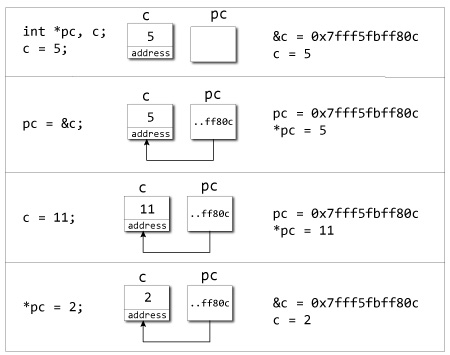在本文中,您将学习有关指针的所有知识。 您将学习如何将值存储在计算机中以及如何使用指针访问它们。
指针是 C++ 的强大功能,可将其与其他编程语言(如 Java 和 Python)区分开来。
指针在 C++ 程序中用于访问内存和操纵地址。
C++ 地址
要了解指针,您首先应该知道如何在计算机上存储数据。
您在程序中创建的每个变量都会在计算机的内存中分配一个位置。 变量存储的值实际上存储在分配的位置。
要知道数据存储在哪里,C++ 有一个&运算符。 &(引用)运算符为您提供变量占用的地址。
如果var是变量,则&var给出该变量的地址。
示例 1:C++ 中的地址
#include <iostream>using namespace std;int main(){int var1 = 3;int var2 = 24;int var3 = 17;cout << &var1 << endl;cout << &var2 << endl;cout << &var3 << endl;}
输出
0x7fff5fbff8ac0x7fff5fbff8a80x7fff5fbff8a4
注意:您的系统上可能不会得到相同的结果。
开头的0x表示地址为十六进制格式。
请注意,第一个地址与第二个地址相差 4 个字节,第二个地址与第三个地址相差 4 个字节。
这是因为在 64 位系统中,整数(类型为int的变量)的大小为 4 个字节。
指针变量
C++ 使您可以直接操作计算机内存中的数据。 您可以根据需要分配和取消分配内存中的任何空间。 这是使用指针变量完成的。
指针变量是指向另一个变量所指向的内存中特定地址的变量。
如何声明一个指针?
int *p;OR,int* p;
上面的语句定义了一个指针变量p。 它保存内存地址
星号是解引用运算符,表示指向p的指针。
此处,指针p是指向int的指针,即它指向内存地址中的整数值。
引用运算符(&)和解引用运算符(*)
如上所述的引用运算符(&)给出变量的地址。
要获取存储在内存地址中的值,我们使用解引用运算符(*)。
例如:如果num变量存储在内存地址0x123中,并且它包含值 5。
引用(&)运算符给出值0x123,而取消引用(*)运算符给出值 5。
注意:在 C++ 指针的声明中使用的(*)符号不是取消引用指针。 只是创建指针的类似符号。
示例 2:C++ 指针
演示指针的工作的 C++ 程序。
#include <iostream>using namespace std;int main() {int *pc, c;c = 5;cout << "Address of c (&c): " << &c << endl;cout << "Value of c (c): " << c << endl << endl;pc = &c; // Pointer pc holds the memory address of variable ccout << "Address that pointer pc holds (pc): "<< pc << endl;cout << "Content of the address pointer pc holds (*pc): " << *pc << endl << endl;c = 11; // The content inside memory address &c is changed from 5 to 11.cout << "Address pointer pc holds (pc): " << pc << endl;cout << "Content of the address pointer pc holds (*pc): " << *pc << endl << endl;*pc = 2;cout << "Address of c (&c): " << &c << endl;cout << "Value of c (c): " << c << endl << endl;return 0;}
输出
Address of c (&c): 0x7fff5fbff80cValue of c (c): 5Address that pointer pc holds (pc): 0x7fff5fbff80cContent of the address pointer pc holds (*pc): 5Address pointer pc holds (pc): 0x7fff5fbff80cContent of the address pointer pc holds (*pc): 11Address of c (&c): 0x7fff5fbff80cValue of c (c): 2

程序的说明
- 当
c = 5;时,值 5 存储在变量c-0x7fff5fbff8c的地址中。 - 当
pc = &c;指针pc保持c-0x7fff5fbff8c的地址时,表达式(取消引用运算符)*pc输出该地址中存储的值,5。 - 由于地址指针
pc保持与c-0x7fff5fbff8c相同,执行表达式*pc时也会反映c的值变化,输出c = 11;。 - 当
*pc = 2;时,它将更改pc-0x7fff5fbff8c存储的地址的内容。 这从 11 更改为 2。因此,当我们打印c的值时,该值也为 2。
使用指针时的常见错误
假设您希望指针pc指向c的地址。 然后,
int c, *pc;pc=c; /* Wrong! pc is address whereas, c is not an address. */*pc=&c; /* Wrong! *pc is the value pointed by address whereas, %amp;c is an address. */pc=&c; /* Correct! pc is an address and, %amp;pc is also an address. */*pc=c; /* Correct! *pc is the value pointed by address and, c is also a value. */
在这两种情况下,指针pc均不指向c的地址。
您还应该查看这些与指针相关的教程:

